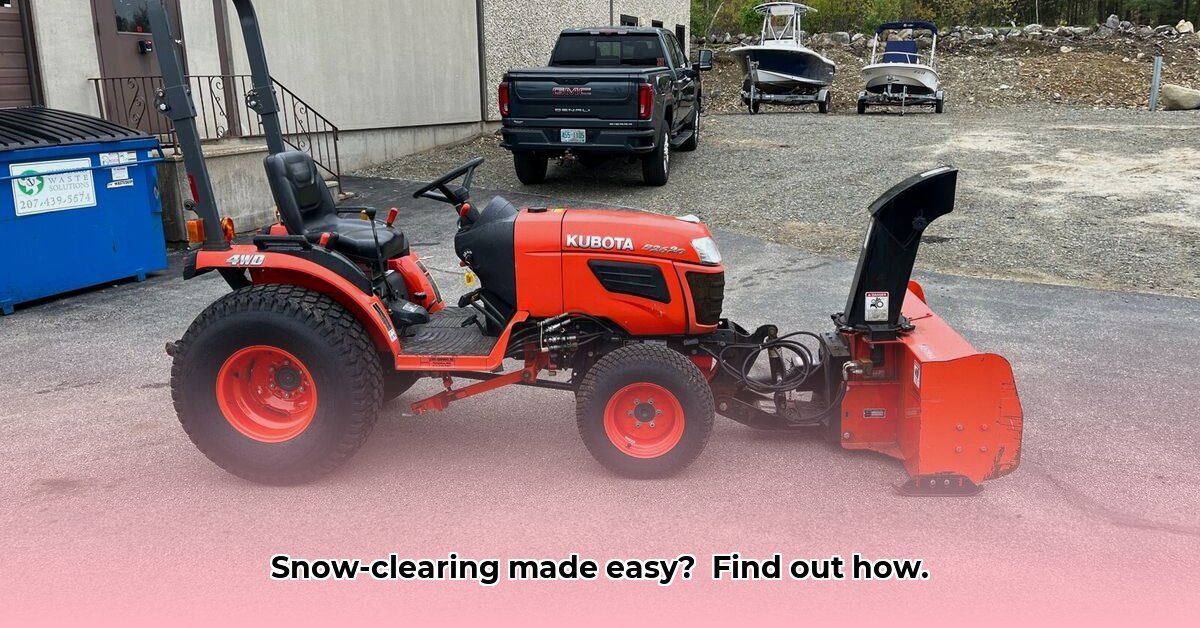
Winter's arrival can significantly disrupt farm operations, but efficient snow removal is crucial for maintaining productivity and protecting valuable assets. This article explores the use of compact tractor snow blowers as a sustainable solution, balancing efficiency with environmental responsibility and economic viability. We'll examine best practices, equipment selection, and long-term strategies to minimize soil compaction and maximize your farm's winter resilience. For more on snow blowers for larger properties, check out this resource.
Efficiency and Productivity: A Winter Game Changer
Snow removal can bring farm work to a standstill. However, a compact tractor with a snow blower attachment offers a powerful solution, dramatically reducing downtime and boosting productivity. The ability to clear pathways and access roads quickly minimizes disruptions, allowing you to return to regular farm tasks sooner. This translates to significant cost savings by reducing lost labor hours and preventing potential equipment damage. A well-maintained machine can also reduce fuel consumption compared to other methods, further enhancing its economic benefits. How else can you ensure uninterrupted operations during the winter months?
Environmental Considerations: Minimizing Your Footprint
While compact tractors offer considerable efficiency gains, environmental impact must be carefully considered. Heavy machinery on soft ground can lead to soil compaction, damaging soil structure and negatively affecting water infiltration, aeration, and overall soil health. However, responsible use can mitigate these risks. In fact, utilizing a compact tractor for snow removal might reduce overall fuel consumption compared to repeated use of larger vehicles, making it a potentially more sustainable solution in some cases. Careful planning and adherence to best practices are key to minimizing the environmental impact.
Economic Considerations: The Total Cost of Ownership
Investing in a compact tractor and snow blower involves a significant upfront cost. However, the long-term financial benefits often outweigh the initial investment. Savings in labor costs, reduced risk of equipment damage from harsh winter conditions, and ongoing time-efficient snow removal can result in substantial returns. The economic viability of this investment depends on factors such as farm size, average snowfall, and frequency of use. Considering leasing options alongside the purchase price should inform your decision. How can you effectively weigh the initial expenditure against projected long-term savings?
Choosing the Right Equipment: Matching Needs to Machine
Selecting the optimal compact tractor and snow blower requires careful consideration of several factors. Farm size, typical snowfall, and budget are crucial starting points. Evaluate blower capacity (snow moved per hour) and tractor horsepower to ensure adequate power for your needs. Prioritize ease of use, maneuverability, durability, and any necessary attachments. Researching reviews and consulting with fellow farmers who utilize similar equipment will prove invaluable. Test-driving different models before purchasing is strongly encouraged.
Best Practices for Sustainable Snow Removal: Smart Snow Management
Minimizing soil compaction and maximizing efficiency are achievable through careful planning and responsible equipment operation. Employ these best practices:
Strategic Routing: Plan efficient snow removal routes, minimizing passes over the same area and avoiding sensitive topsoil or fragile vegetation.
Optimal Timing: Avoid operating on wet or thawing ground, as this significantly increases the risk of compaction. Wait until the ground is frozen or restrict usage to paved areas.
Regular Maintenance: Regular maintenance prolongs equipment life and improves efficiency, reducing the frequency of passes needed.
Gentle Operation: Slow, controlled movements minimize stress on the soil and the equipment, promoting both sustainability and longevity.
Maintenance and Troubleshooting: Keeping Your Investment Running Smoothly
Preventive maintenance is crucial for maximizing the lifespan of your compact tractor and snow blower. Regular service intervals, as specified in your owner's manual, will ensure optimal performance and prevent costly repairs down the line. Addressing minor issues promptly will prevent them from escalating into major problems, ensuring your investment continues to provide long-term value.
The Future of Sustainable Snow Removal: What's on the Horizon?
Continued advancements in compact tractor technology promise even greater efficiency and reduced environmental impact. Future innovations may include more fuel-efficient engines, enhanced design features to minimize soil compaction, and perhaps the integration of alternative fuel sources. The development and adoption of electric tractors are also shaping the future of sustainable snow removal. Staying informed about these technological developments will enable you to make informed choices for your farm in the years to come.
Dr. Emily Carter, Agricultural Engineering Professor at Cornell University, notes: "Sustainable snow removal is not just about efficiency, it's about integrated farm management. By adopting these strategies, farmers can protect soil health and reduce their environmental footprint."